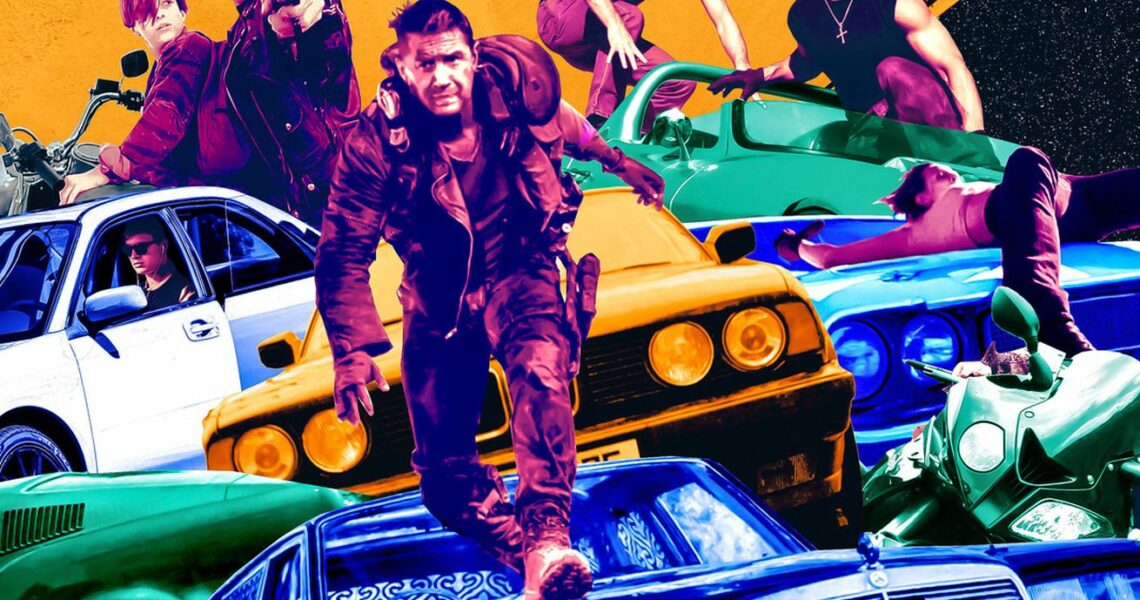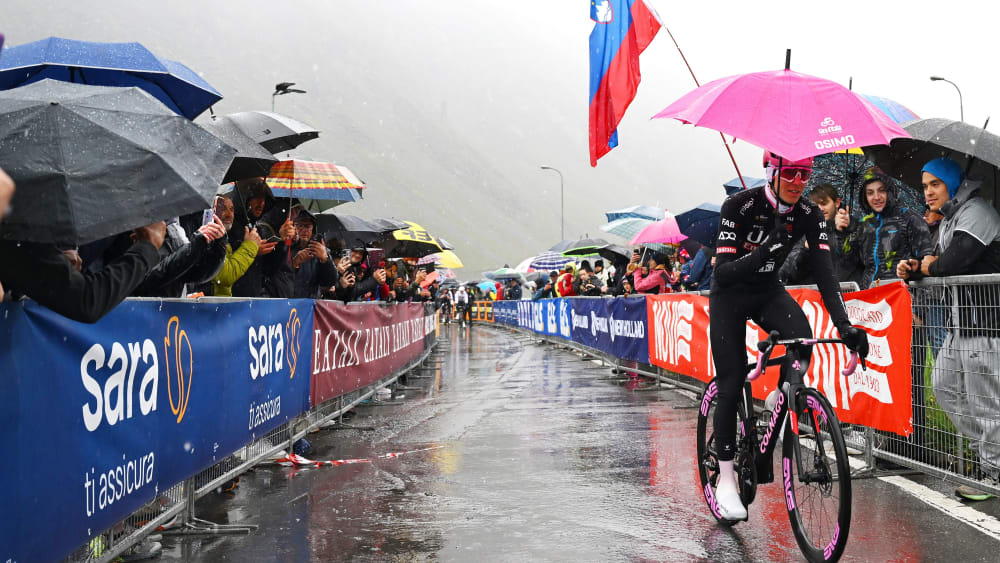
In honor of the imminent ‘Furiosa: A Mad Max Saga,’ we’re shifting into high gear to determine the best chase scene in cinema history
Its two stars hated each other. It won six Oscars. It made Bong Joon-ho cry tears of joy. And now, its prequel is almost upon us.
After wowing audiences with Mad Max: Fury Road, director George Miller returns to the franchise’s post-apocalyptic wastelands for Furiosa, the epic origin story of the eponymous heroine (now played by Anya Taylor-Joy), premiering on Friday. As the follow-up to one of the greatest action films ever made, it’s hard to overstate the hype for Furiosa, and that was before word got out about a showstopping 15-minute sequence that required nearly 200 stuntpeople and took 78 days to shoot. While Furiosa will have its own distinct flavor, as is true of every Mad Max movie, there’s one thing that unites these projects: intense, jaw-dropping scenes of vehicular mayhem. And what better way to honor the franchise than by celebrating what it does best?
Ahead of Furiosa’s release, we’ve put together our definitive ranking of the best car chases in cinema. There weren’t any strict rules in place, other than capping the list at 20—mostly for my own sanity—and limiting every franchise to one entry. (Apologies to Fury Road’s kickass predecessor The Road Warrior.) We also won’t discriminate against scenes that feature motorbikes, so long as cars (and/or trucks) remain part of the equation. As for what, exactly, constitutes a good car chase? Like list making, it’s bound to be subjective, but I tend to gravitate toward two key elements: the skill of the stuntwork on display and the ways in which a filmmaker conveys the action in relation to the story. (Also, the less CGI, the better.) Buckle up, ’cause we’re not wasting any time shifting into high gear.
20. Quantum of Solace (2008)
There have been some memorable car chases in the James Bond franchise: the first sequence featuring the iconic Aston Martin DB5 in Goldfinger, the corkscrew jump in The Man With the Golden Gun, the Lotus Esprit submarine in The Spy Who Loved Me. But I’m going with a somewhat controversial pick here: Quantum of Solace. There are many issues with Quantum of Solace—namely, it was one of the most high-profile blockbusters affected by the 2007-08 writers strike—but its opening scene isn’t one of them. Picking up right where Casino Royale left off, we find Bond (Daniel Craig) evading henchmen through the narrow roads around Italy’s Lake Garda. The frenetic, furious chase mirrors Bond’s sense of anguish after losing Vesper Lynd (Eva Green), the woman he opened his heart to, and his relentless quest for answers. It’s a thrilling tone-setter for Quantum of Solace and one that doesn’t overstay its welcome, capped off by Bond sending his final pursuers flying off a cliff:

If we’re being honest, though, it feels like James Bond has yet to create a franchise-defining car chase. Perhaps that’s a mission the newest 007, whoever it ends up being, can undertake.
19. Mission: Impossible—Rogue Nation (2015)
The Mission: Impossible franchise is no stranger to electrifying chase scenes, the best of which find Tom Cruise’s Ethan Hunt working up his heart rate. When it comes to action behind the wheel, though, Fallout tends to dominate the discussion—even on this very website. But I think the vehicular chase in Rogue Nation is being slept on. What we have is effectively two sequences for the price of one: The first finds Hunt pursuing Ilsa Faust (Rebecca Ferguson) by car through the narrow streets of Casablanca alongside some nefarious henchmen; the second sees him continue the chase outside the city on motorbike. (Adding to the chaos: Hunt had only just been resuscitated, and he’s clearly not all there.) In terms of death-defying stunts for the audience’s entertainment, a helmetless Cruise taking corners like a MotoGP racer is child’s play compared to his other exploits, but the actor’s authentic reaction to scraping his knee on the road underlines that there’s no one else in Hollywood doing it like him:

We’ll be sure to update this ranking if and when Cruise does something even more dangerous down the road, pun unintended.
18. Vanishing Point (1971)
A movie that counts the likes of Steven Spielberg and Quentin Tarantino among its biggest fans, Vanishing Point is the first of a few entries on this ranking that’s essentially one extended car chase. The film stars Barry Newman as Kowalski, a man tasked with delivering a Dodge Challenger R/T 440 Magnum from Colorado to California while eluding police across four states. One of Kowalski’s most memorable run-ins comes when a guy driving a Jaguar E-Type convertible challenges him to an impromptu race. Incredibly, we’re expected to believe the man in the Jag comes out of this crash in one piece:

Vanishing Point might not boast the impressive production values of other movies on this list, but considering Tarantino would go on to feature a white Challenger in Death Proof, its influence in the car cinema canon is undeniable.
17. Fast Five (2011)
Let’s face it, Fast & Furious has seen better days. Some believe the franchise’s dip in quality coincided with the death of Paul Walker; others are dismayed by the pivot from street racing to absurd feats of superherodom—emphasis on the Dom. Perhaps it’s a bit of both, but the very best movie in the series, Fast Five, manages to strike the perfect balance: It’s a relatively grounded heist thriller that nevertheless takes the franchise to ridiculous new heights. After Dominic Toretto (Vin Diesel) and his crew steal $100 million from a Brazilian kingpin, they drag the entire bank vault holding the money through the streets of Rio de Janeiro, all while being pursued by authorities. It’s a delightfully destructive sequence that does untold damage to Rio’s infrastructure and features some of the most bone-crunching crashes committed to film:

If the Fast franchise is going to break out of its recent slump, it would do well to remember that there’s nothing better than letting its heroes live their lives a quarter mile at a time—no detours to outer space required.
16. The Blues Brothers (1980)
A good car chase isn’t reserved just for action flicks: Comedies can get in on the act, too. In The Blues Brothers, starring the recurring Saturday Night Live characters played by John Belushi and Dan Aykroyd, the beloved bandmates must prevent the foreclosure of the orphanage where they were raised by scrounging together $5,000. Naturally, that’s easier said than done: Along the way, the Blues Brothers draw the attention of neo-Nazis, a country-and-western band, and local police. While The Blues Brothers has amusing gags and musical numbers, its chase sequences with the Brothers behind the wheel of a 1974 Dodge Monaco are what really steal the show—and none are better than a climactic pursuit across Chicago. More than 60 old police cars were used in the film, some of which are wrecked in a comically over-the-top pileup:
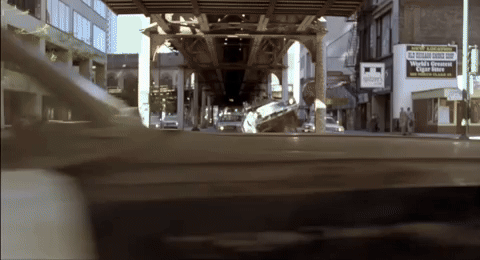
The sheer scale of The Blues Brothers’ final set piece is commendable in and of itself—as is the movie’s commitment to treating real-life cars like a bunch of Hot Wheels.
15. Baby Driver (2017)
For good and for ill, Edgar Wright’s movies exude an abundance of style, and Baby Driver is no exception. Baby Driver is centered on a clever gimmick: The action works in tandem with its soundtrack because the film’s protagonist, Baby (Ansel Elgort), suffers from tinnitus and constantly plays music to drown out the ringing. When everything’s clicking into place, Baby Driver feels like a supersized series of music videos, and nothing hits quite like its opening sequence. Baby acts as the getaway driver for a bank robbery while listening to the Jon Spencer Blues Explosion’s “Bellbottoms.” The ensuing chase works around rhythms of the song, as if Baby’s Subaru WRX were the star of its own dance number. Take nothing away from the actual driving, either, which puts the rally car to good use:

Baby Driver’s gimmick stretches a little thin by the end, but it’s hard to deny the crowd-pleasing power of Wright’s film when it’s firing on all cylinders.
14. The Raid 2 (2014)
With a trio of kickass Indonesian martial arts films under his belt, Gareth Evans has established himself as one of the most exciting action directors on the planet—someone who seems most in his element staging positively brutal hand-to-hand combat. In The Raid 2, however, Evans also brought his signature brand of carnage to the road. While there’s some cleverly executed close-quarters fighting within the confines of an SUV, courtesy of Iko Uwais’s hard-hitting protagonist, what really cements this sequence’s greatness are the moments when Evans turns the cars into an extension of the characters’ fists:

This belongs in an entirely new category of combat: car fights. There are so many action scenes in The Raid 2 worth writing home about—the kitchen showdown is an all-timer—but the fact that Evans casually tossed in an unforgettable car chase shows why he’s one of one.
13. The Driver (1978)
I’ll say this for Walter Hill’s The Driver: It sure lives up to its title. In this stripped-down thriller—one where none of the characters have a name—we follow the Driver (Ryan O’Neal), a getaway driver who has become a thorn in the side of the LAPD. In the film’s best scene, we see its taciturn protagonist living up to his reputation. With the Driver behind the wheel of a 1974 Ford Galaxie, a cat-and-mouse game unfolds when a handful of police cars are hot on his tail. What I love about this sequence is the pared-down nature of it all: The Driver outwits the cops as much as he outraces them. (Though, ironically, that wasn’t entirely by design: As Hill later explained, an accident on the last night of shooting meant they had to cobble together what had already been filmed.) Frankly, you’d never know the difference from the finished article:
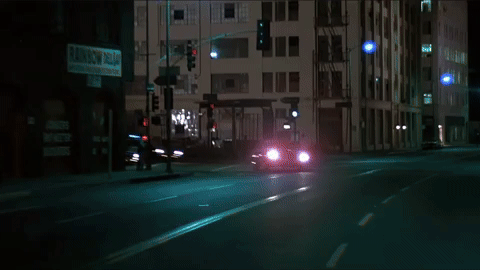
If the general vibes of The Driver seem familiar, that’s because it was a major inspiration for Nicolas Winding Refn’s Drive, which just so happened to feature an unnamed protagonist (Ryan Gosling) evading police through the streets of Los Angeles.
12. The Bourne Supremacy (2004)
The shaky-cam style of the Bourne franchise isn’t for everyone—just ask John Woo—but credit where it’s due: These movies know how to deliver a good chase scene. (A friendly reminder that The Bourne Legacy is an underrated gem with an awesome motorbike sequence to boot.) But there’s one Bourne chase that stands above the rest: the Moscow getaway in The Bourne Supremacy. After being wounded by the Russian assassin Kirill (Karl Urban), Jason Bourne (Matt Damon) hijacks a taxi, with both the police and Kirill in hot pursuit. This isn’t the kind of sequence that lingers on any one shot; instead, what makes it work is the frenetic nature of the editing, which allows the viewer to feel like they’re in Bourne’s fight-or-flight headspace:

If I’m being honest, I’m usually one of those people who doesn’t like the Bourne movies’ shaky-cam style, but when it’s executed with such craftsmanship, you can’t help but get caught up in its adrenaline-pumping power.
11. The Seven-Ups (1973)
Philip D’Antoni was the producer of two movies featuring Hall of Fame car chases, Bullitt and The French Connection, the latter of which won him an Oscar for Best Picture. And with his lone directorial feature, The Seven-Ups, D’Antoni sought to craft an iconic sequence of his own. The film stars Roy Scheider as NYPD detective Buddy Mannuci (elite Italian American name; I can practically smell the gabagool), who commands a unit handling major felony cases that lead to seven-plus-year prison sentences; that’s why they’re known as the Seven-Ups. Midway through the movie, when one of the team members is killed by two shooters who flee the scene, Buddy chases after them. The 10-minute sequence, which starts in the Upper West Side before moving out of the city, is thrillingly immersive, alternating between close-ups of the characters and wider shots of all the damage they’ve caused. But the chase’s defining moment comes right at the end, when Buddy narrowly avoids a grisly death:
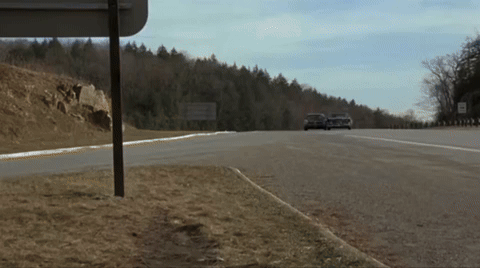
The sequence isn’t quite at the level of Bullitt or The French Connection—very few are—but D’Antoni still manages to leave an unmistakable imprint on the car chase canon.
10. Death Proof (2007)
If you ask Quentin Tarantino, Death Proof, his knowingly trashy tribute to exploitation cinema, is the worst movie he’s ever made. But that doesn’t mean there isn’t a lot to admire about the film, which honors the unsung heroes of Hollywood: stunt performers. The first half of Death Proof follows three female friends who cross paths with Stuntman Mike (Kurt Russell), a misogynistic serial killer who takes them out in his “death-proof” Chevy Nova. Fourteen months later, a group that includes stuntwoman Zoë Bell, playing herself, also lands on Mike’s radar. As Bell and her friends test out a ’70s Challenger, she performs a “ship’s mast” stunt, clinging onto the hood of the car with fastening belts. Unfortunately, when Mike pursues the women, it puts Bell in a precarious situation. Most of the entries on this list celebrate some next-level driving skills, but Death Proof’s inclusion is all about Bell pulling off one of the wildest stunts you’ll ever see. She’s quite literally hanging on for dear life:
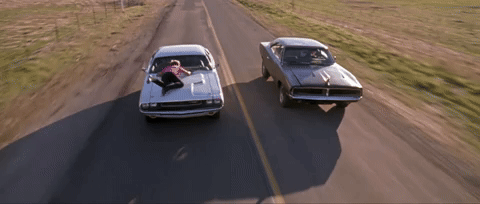
If the Academy handed out Oscars to stunt performers—and let’s hope it does happen one day—Bell would’ve won in a landslide.
9. To Live and Die in L.A. (1985)
William Friedkin was already responsible for an all-time great car chase in The French Connection (more on that later), but the filmmaker made a commendable bid to outdo himself with To Live and Die in L.A. In this neo-noir thriller, Secret Service agent Richard Chance (William L. Petersen) is hell-bent on arresting an expert counterfeiter, Rick Masters (Willem Dafoe), who kills Chance’s partner days before his retirement. To capture Masters, Chance and his new partner, John Vukovich (John Pankow), attempt to steal $50,000 from a jewelry buyer for an undercover operation. The sting goes bad when the buyer, who is later revealed to be an undercover FBI agent, is killed and a group of gunmen goes after Chance and Vukovich. It’s a clever inversion of the usual car chase formula—this time, it’s the lawmen running away from the criminals. The outside-the-box thinking extends to the film’s most astonishing stretch, in which Chance evades the gunmen by driving into oncoming traffic:
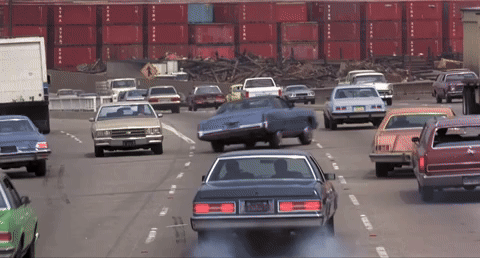
The fact that Friedkin shot the chase at the end of filming—in case anything disastrous happened to the actors—underscores just how risky the endeavor was. The pulse-pounding results speak for themselves.
8. The Matrix Reloaded (2003)
The Matrix sequels have never been held in high esteem, but I’m ready to live my truth: The Matrix Reloaded fucking rules. (If anyone’s got a problem with this take, file your complaints with the Architect.) What’s more, the film happens to boast the finest action set piece of the franchise: the highway chase. After Morpheus (Laurence Fishburne) and Trinity (Carrie-Anne Moss) free the Keymaker (Randall Duk Kim), a program capable of creating shortcuts within the Matrix, they’re pursued by the Twins (Neil and Adrian Rayment). Morpheus once warned that going on the freeway was “suicide,” and it doesn’t take long to see why: The chase draws the attention of several Agents, who repeatedly take over the bodies of other drivers on the road. The scene is the best of both worlds: There’s some incredible stuntwork on display, including when Moss weaves around on a Ducati, and CGI augments some feats of superhuman strength. But the most jaw-dropping aspect of the sequence is how it came together, as the production spent $2.5 million to construct its own highway (!) on California’s Alameda Island. If that weren’t unique enough, I’m pretty sure Reloaded is also the only movie in existence in which a katana takes out an SUV:

The Matrix remains the Wachowskis’ masterpiece, but don’t get it twisted: The filmmakers were still cooking with gas in the sequel.
7. Gone in 60 Seconds (1974)
Size isn’t everything, but for H. B. Halicki, who produced, wrote, directed, and starred in Gone in 60 Seconds, it’s certainly part of the package. The indie action flick follows Maindrian Pace (Halicki), a Los Angeles insurance investigator who has a lucrative side hustle jacking high-end cars. The plot kicks into motion when a South American drug lord enlists Pace to nab 48 cars within five days in exchange for $400,000. Of course, Gone in 60 Seconds is best known for what happens after Pace is caught stealing a 1973 Ford Mustang Mach 1, when he leads police on a chase that lasts a whopping 40 minutes. (More than 90 cars were destroyed in the process.) Halicki, for his part, did all the driving himself, including a spectacular jump off a makeshift ramp of crashed cars:

While Halicki wound up making a few more indies after Gone in 60 Seconds, he died in an accident on the set of its sequel. His legacy as a do-it-all daredevil, however, lives on.
6. Terminator 2: Judgment Day (1991)
Long before James Cameron immersed himself in the world of Pandora, he was a pioneer of state-of-the-art visual effects. Case in point: Terminator 2: Judgment Day is credited for having the first CGI character in a blockbuster, the T-1000 (Robert Patrick), a killing machine composed of a futuristic liquid metal. But Cameron also understood that the CGI of that era shouldn’t be the main attraction: It worked best as a complement to the practical effects, as seen in Judgment Day’s epic viaduct chase. When the T-1000 tracks down a young John Connor (Edward Furlong) in a shopping mall, he’s saved at the last minute by the Terminator (Arnold Schwarzenegger), giving John a chance to escape on his dirt bike. As the T-1000 gives chase, the David and Goliath vibes between man and machine are further epitomized by the T-1000’s commandeering of a truck. The sequence already has a terrifying sense of urgency, but it hits another level when the T-1000 crashes through the viaduct like the Kool-Aid Man:

Big Jim is still revolutionizing what can be achieved with visual effects in the Avatar franchise, and while I cherish those movies, nothing beats his old-school showmanship.
5. Duel (1971)
The feature-length debut of Steven Spielberg—perhaps you’ve heard of him—the TV movie Duel is essentially one extended chase sequence between salesman David Mann (Dennis Weaver) and a sinister trucker determined to drive him off the road. I’ve attached a clip from the ending of the film, but that doesn’t do Duel justice. What cements this movie’s greatness is how it sustains an unbearable level of tension across its 90-minute running time—with a budget under $500,000, no less. Spielberg’s masterstroke is never once showing us the other driver, anthropomorphizing the truck itself as a monster. (You can see a lot of similarities with how he would build suspense in Jaws.) When Mann finally gets the upper hand, tricking his adversary into driving off a cliff, it feels like you can breathe again:

Spielberg would move on to bigger and better things after Duel, but considering how much the director accomplished with so little, you can’t help but wonder what else he could conjure up with limited resources.
4. Mad Max: Fury Road (2015)
Like Duel, Fury Road is basically one long car chase—the difference is Miller got to work with a blockbuster budget, and made every cent of it count. It’s hard to pick a single standout sequence in Fury Road, but if I had to choose, I’d go with the first attack on the War Rig after Furiosa (Charlize Theron) flees with the wives of Immortan Joe (Hugh Keays-Byrne). Here’s why: Think back to when you saw Fury Road for the first time, before you fully grasped the vehicular carnage that was in store. And then stuff like this kept happening:
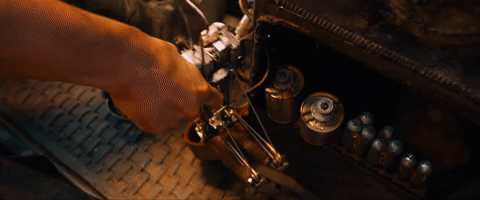
To quote Steven Soderbergh’s thoughts on Fury Road: “I don’t understand how they’re not still shooting that film and I don’t understand how hundreds of people aren’t dead.” Whether or not Miller manages to one-up the action in Furiosa, the director is already in the pantheon.
3. The French Connection (1971)
We return to the Friedkin-verse for what may be his best film, The French Connection, the crime thriller based on Robin Moore’s 1969 nonfiction book of the same name. The story concerns two NYPD detectives, Jimmy “Popeye” Doyle (Gene Hackman) and Buddy “Cloudy” Russo (Roy Scheider), and their tireless pursuit of a French heroin smuggler. But while there’s plenty to admire about how The French Connection illustrates the thin line between police and criminals, its greatest claim to fame is its car chase. After Popeye narrowly survives a sniper attack, he goes after the shooter, who escapes on an elevated train. The ensuing sequence is true daredevil filmmaking that Friedkin shot without permits, leading to real crashes with New Yorkers that made the final cut. But Friedkin’s finest touch was mounting a camera to the front of the car, making the audience feel like they’re part of the action:
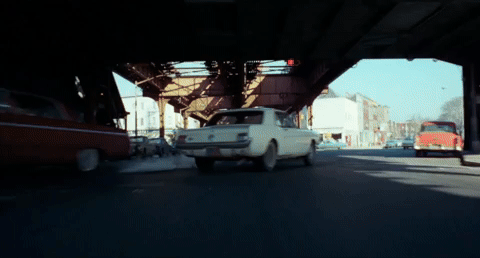
My Ringer colleague Justin Sayles believes The French Connection’s chase should’ve landed at no. 1, and I’m sure many folks will agree with him. Being the only film on this list to win Best Picture, however, is a solid consolation prize.
2. Bullitt (1968)
When it comes to modern car chases, all roads lead back to Bullitt. A Dad Cinema classic, the film stars Steve McQueen as Frank Bullitt, a San Francisco detective who pursues a group of mobsters after a key witness is killed in protective custody. In his search for answers, Bullitt realizes he’s being tailed by a couple of hitmen, and then turns the tables on them. From there, the chase is on. Aside from McQueen doing most of his own stunts behind the wheel of a Ford Mustang GT 390 Fastback, what’s so impressive about the sequence is how timeless it is. Even the little imperfections, like hubcaps repeatedly coming off the wheels, work to the film’s advantage, stressing just how much these drivers are living on a razor’s edge. It’s been more than 50 years since Bullitt revolutionized the car chase, and yet few movies since have felt like they’re pushing the envelope to such an exhilarating degree:
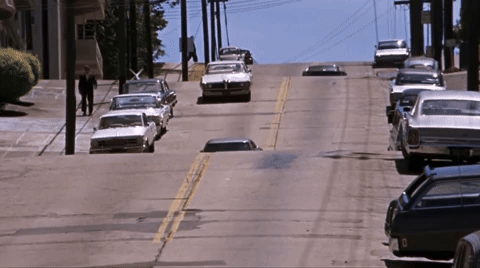
That the car driven by McQueen was recently sold at auction for $3.74 million, a then-record price for a Mustang, underlines Bullitt’s enduring legacy.
1. Ronin (1998)
“If I’m going to do a car chase,” filmmaker John Frankenheimer said in an interview with the American Society of Cinematographers, “I’m going to do a car chase that’s going to make somebody think about whether or not they want to do another one!” Boy, did he ever. In Frankenheimer’s late-career masterpiece, Ronin, the director actually incorporated several chases, but it’s the climactic sequence that stands alone as the greatest ever filmed. The movie concerns an international group of mercenaries who are hired to steal a mysterious briefcase; a series of double-crosses and double-bluffs ensue. But for the final chase, all you need to know is that Sam (Robert De Niro), a mercenary with ties to the CIA, is in pursuit of Deirdre (Natascha McElhone), an IRA operative in possession of the case. Winding through the streets and tunnels of Paris, what’s most striking is just how fluid it all feels. You’re completely engrossed in the chase’s forward momentum, captured from every conceivable angle; a symphony of controlled chaos. The driving styles even reflect the characters: Deirdre is reckless and impulsive, while Sam remains calm and controlled.

There are many worthy car chases in this ranking, but in my view, Ronin takes pole position. And while I can’t imagine a movie ever topping what Frankenheimer achieved, I’d love nothing more than to be proved wrong.

